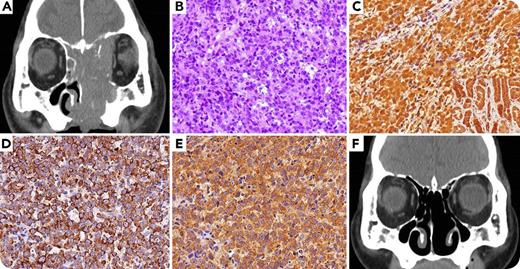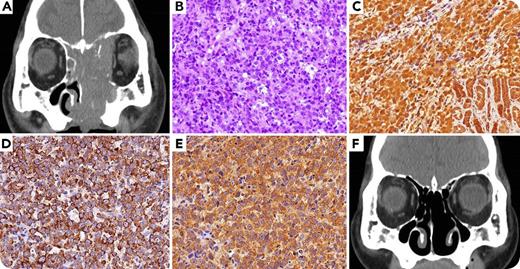A 78-year-old man was admitted for diplopia. Computed tomography revealed a tumor mass in the left nasal cavity (panel A). Blood analysis showed the following: albumin, 46 g/L (normal, 38-53 g/L); calcium, 2.6 mmol/L (2.0-2.5 mmol/L); 25(OH)D3, 82.4 nmol/L (74.9-249.6 nmol/L); 1,25(OH)2D3, 196.0 pmol/L (52.0-156.0 pmol/L); parathyroid hormone (PTH), 19.4 ng/L (8.3-38.7 ng/L); and PTH-related protein, <1.0 pmol/L. The nasal tumor was biopsied and eventually diagnosed as diffuse large B-cell lymphoma (DLBCL), not otherwise specified (panel B; hematoxylin and eosin stain, original magnification ×400), of non–germinal center B-cell subtype, stage IV, with a high International Prognostic Index score. Furthermore, lymphoma cells were positive for 25-hydroxyvitamin D3-1α-hydroxylase (panel C, inset with normal kidney as the positive control; original magnification ×400), interleukin-6 (panel D; original magnification ×400), and tumor necrosis factor-α (panel E; original magnification ×400). Following rituximab, cyclophosphamide, doxorubicin, vincristine, and prednisolone therapy, the lymphoma lesions disappeared (panel F), and both serum calcium and 1,25(OH)2D3 levels decreased to 2.2 mmol/L and 142.2 pmol/L, respectively.
Vitamin D deficiency has been recently proven to impair outcomes of patients with DLBCL treated with rituximab-based therapy. In this case, the extrarenal 25-hydroxyvitamin D3-1α-hydroxylase production and proinflammatory cytokine production by lymphoma cells were considered to play a role in the pathogenesis of hypercalcemia.
A 78-year-old man was admitted for diplopia. Computed tomography revealed a tumor mass in the left nasal cavity (panel A). Blood analysis showed the following: albumin, 46 g/L (normal, 38-53 g/L); calcium, 2.6 mmol/L (2.0-2.5 mmol/L); 25(OH)D3, 82.4 nmol/L (74.9-249.6 nmol/L); 1,25(OH)2D3, 196.0 pmol/L (52.0-156.0 pmol/L); parathyroid hormone (PTH), 19.4 ng/L (8.3-38.7 ng/L); and PTH-related protein, <1.0 pmol/L. The nasal tumor was biopsied and eventually diagnosed as diffuse large B-cell lymphoma (DLBCL), not otherwise specified (panel B; hematoxylin and eosin stain, original magnification ×400), of non–germinal center B-cell subtype, stage IV, with a high International Prognostic Index score. Furthermore, lymphoma cells were positive for 25-hydroxyvitamin D3-1α-hydroxylase (panel C, inset with normal kidney as the positive control; original magnification ×400), interleukin-6 (panel D; original magnification ×400), and tumor necrosis factor-α (panel E; original magnification ×400). Following rituximab, cyclophosphamide, doxorubicin, vincristine, and prednisolone therapy, the lymphoma lesions disappeared (panel F), and both serum calcium and 1,25(OH)2D3 levels decreased to 2.2 mmol/L and 142.2 pmol/L, respectively.
Vitamin D deficiency has been recently proven to impair outcomes of patients with DLBCL treated with rituximab-based therapy. In this case, the extrarenal 25-hydroxyvitamin D3-1α-hydroxylase production and proinflammatory cytokine production by lymphoma cells were considered to play a role in the pathogenesis of hypercalcemia.
For additional images, visit the ASH Image Bank, a reference and teaching tool that is continually updated with new atlas and case study images. For more information, visit http://imagebank.hematology.org.



